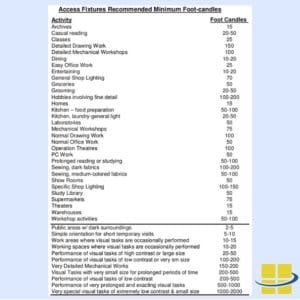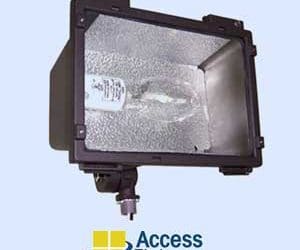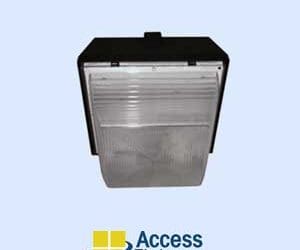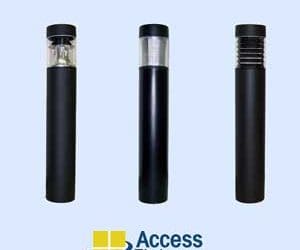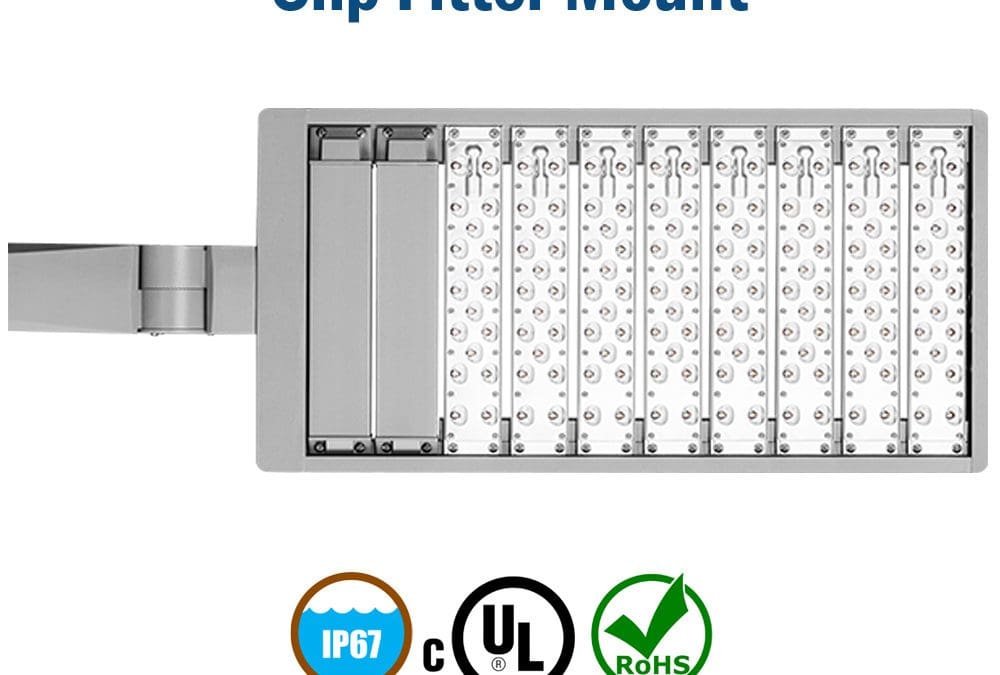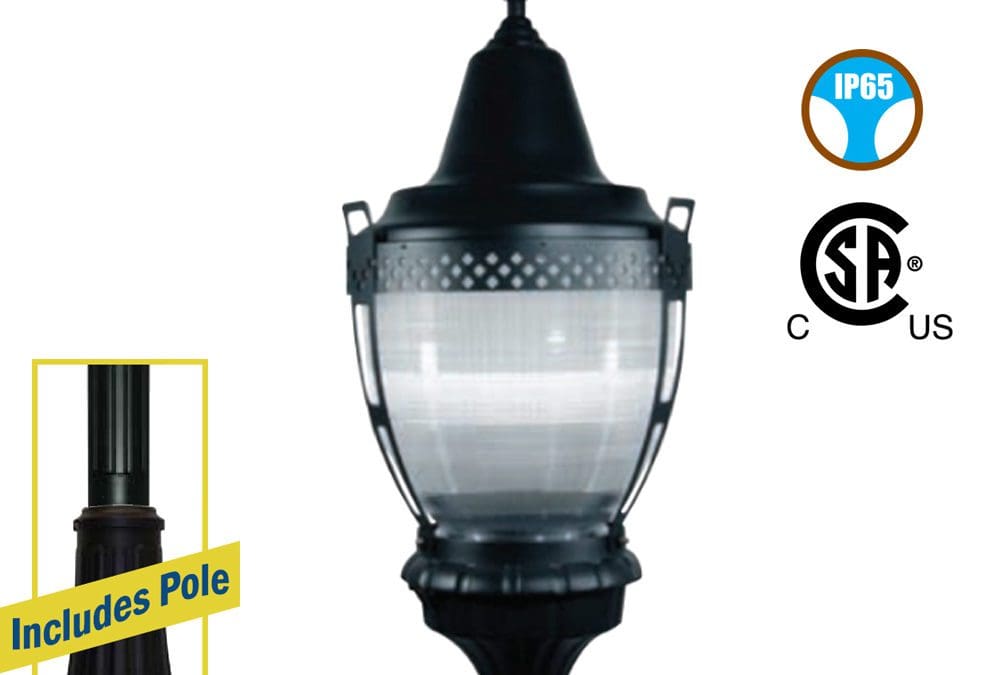Recommended Minimum Footcandles
Embracing any new technology can be difficult at first. LED has proven to be no exception to this adjustment process. Old lighting technologies limited the range of wattage, efficiency, and customization; unfortunately, though, we haven’t really had other options. LED, however, is more efficient and powerful than its predecessors. A 6–9w LED light can easily provide the same amount of light as a 60w incandescent.
Accurate foot candle readings are crucial in ensuring proper lighting levels in various settings, such as offices, museums, and horticulture, to meet specific functional or aesthetic needs.
It seems almost too good to be true, and we understand how making the switch can be a confusing and costly process if you’re not sure what metrics to look for. One of the most common conversations we have with our customers is about footcandles. So… what are footcandles and how many do you need?
Footcandles vs. Wattage: The Numbers Matter
While we may be conditioned to pick out replacement light fixtures based on wattage, it’s actually not the best way to choose a light fixture. If you were to replace your 60w incandescent bulbs with a 60w LED (or 20w, even), you would end up with way more light than you were expecting. Wattage only measures how much electricity a fixture uses. Since they are so efficient, LED requires much less energy to produce the same amount of light.
So how do you determine which light fixture is going to be the best replacement if you can’t just swap them out, watt for watt, like in the old days?
The actual measurement of how much light a lamp emits is referred to as “lumens.” However, the total lumens produced by a fixture, or “light source lumens,” is not always equivalent to the number of lumens that are actually delivered. One way to measure the amount of light thrown from a fixture is by “footcandles” (fc). When choosing an LED light, two of the most important data points to consider are lumens and footcandles. You can see a guide of recommended foot-candles here.
A light meter is an essential tool for measuring footcandles accurately.
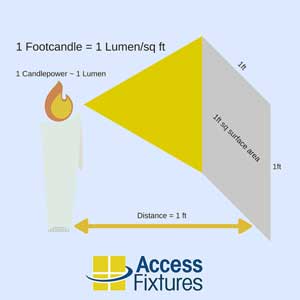
Footcandle Diagram
The Origin of Foot-Candles
The concept of foot candles is older than electricity itself. It is commonly believed that, in the days of beeswax candles, someone decided to create a “standard candle.” The light thrown from that candle became the standard for “candlepower.” Since then, one foot candle has been known as approximately one lumen per square foot.
In the lighting industry, footcandles are a fairly common unit of measurement used to determine how much light will be optimal for work spaces, retail venues, buildings, or outdoor spaces. By examining the specifications of your lighting project and comparing LED options with your current fixtures, you can get a better idea of what LED fixtures will be best for your space.
Find the Right LED Light Fixture with the Right Lumens
It may seem unbelievable, but determining how many footcandles your project needs doesn’t have to be a complicated math problem. These days, we have the advantage of technology that will evaluate footcandle data, spacial dimensions, lumen efficacy, and wattage to determine how a light source will function in your space. Understanding how many foot candles are needed for various spaces and activities is crucial for ensuring adequate illuminance and compliance with lighting standards. The experts at Access Fixtures are trained to perform these photometric analyses and help you find the optimal solution for your lighting project.
Conclusion
Switching to LED lighting might seem daunting at first, especially when transitioning from older, less efficient technologies that limited wattage, efficiency, and customization. LED lights, however, offer a significant leap in efficiency and power. A 6–9w LED light can provide the same illumination as a 60w incandescent bulb, making it an attractive option for energy savings and performance. Despite this, understanding the key metrics, such as lumens and footcandles, can make the switch feel complex and overwhelming. Fortunately, footcandles—a measure of how much light reaches a surface—are a crucial consideration, providing a clearer understanding of light output compared to the outdated wattage method. Light intensity, measured in footcandles, is crucial for understanding how much light reaches a surface area. By focusing on footcandles and lumens, rather than watts, and leveraging modern technology for precise lighting analysis, you can make well-informed decisions for optimal lighting solutions.
Speak to an Access Fixtures Lighting Specialist about Choosing the right Fixture
Struggling to figure out which LED light will be the best replacement for your traditional fixtures? Specialists can help determine how many fixtures are needed for specific areas or projects. Call the lighting specialists at Access Fixtures today! We can help you find the right fixture to light your commercial, industrial, or sports facility with just the right amount of footcandles. Contact us at 800-468-9925.
Frequently Asked Questions
Why should I switch to LED lighting from traditional lighting technologies?
LEDs are more efficient, powerful, and customizable compared to older lighting technologies. A 6–9w LED light can provide the same amount of light as a 60w incandescent bulb, significantly reducing energy consumption and costs.
What are footcandles, and why are they important?
Footcandles (fc) measure the amount of light that reaches a surface, with one footcandle being approximately one lumen per square foot. Foot candle readings are crucial for determining the appropriate lighting conditions in various environments. This measurement helps determine the optimal lighting for various spaces, ensuring sufficient illumination for tasks and safety.
How do footcandles differ from wattage?
Wattage measures the electricity a fixture uses, not the light output. Footcandles measure the actual light delivered to a surface, providing a more accurate metric for selecting the right light fixture.
How do lumens relate to footcandles?
Lumens measure the total light emitted by a lamp, while footcandles measure the light reaching a specific area. Not all emitted lumens reach the intended surface, making footcandles a crucial metric for evaluating actual lighting performance.
Can I replace my 60w incandescent bulbs with 60w LEDs directly?
No, because LEDs are more efficient. A 60w LED would produce much more light than a 60w incandescent. Instead, consider the lumens and footcandles needed for your space to find the appropriate LED replacement.
What is the history behind the term “footcandles”?
The term dates back to before electricity when a “standard candle” was used to measure light. One footcandle represents the light produced by one standard candle spread over a square foot.
How are footcandles used in modern lighting design?
Footcandles are used to determine the optimal lighting for workspaces, retail venues, buildings, and outdoor areas. Achieving high footcandle levels is insufficient if the lighting consists of a single bright light source, as it can create harsh shadows and inconsistency. They help ensure that lighting meets the specific needs of each space.
What tools can help me determine the footcandles needed for my project?
Modern technology evaluates footcandle data, spatial dimensions, lumen efficacy, and wattage to determine how a light source will function in your space. Photometric analyses performed by experts can provide precise recommendations.
How do I choose the right LED fixture for my space?
By comparing the specifications of your current fixtures with potential LED options and considering lumens and footcandles, you can select an LED fixture that meets your lighting needs efficiently.
Where can I get expert advice on LED lighting and footcandles?
The experts at Access Fixtures are trained to perform photometric analyses and can help you find the optimal lighting solutions for your project, ensuring you achieve the best performance and efficiency from your LED lighting.

